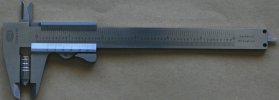462
California's Central Coast Amid The Insanity
Bass Ackwards?Wasn't it Gear who said, "It doesn't matter until it does."?
Bass Ackwards?Wasn't it Gear who said, "It doesn't matter until it does."?
I call it good at 1/16” which still is a bit tight for expansion and contracting.Definitely Bass, I've quoted him a lot on that phrase, though I'm the guy who built his whole two-story house from scratch using cabinetmaker's tolerances. That's +/- 1/32" which is all you can fudge without splitting hardwood. Most doors and casings were built by me and fit so close they are damned near airtight. Don't do that, it sucks the eardrums out of a person in the room when you open the door fast.
Yes Mitutoyo.....but remember they are called Verynears for a reason....So which ones do you use?

Nice caliper. Never seen a Mauser branded measuring tool.
Use one very much and a vernier can be read almost as quickly and every bit as accurately as a dial or digital. Each type has their own good and bad qualities.
I don’t think drafting is even offered these days. I took a one-year drafting class in high school (taught by Mr. Müller). While I never used the knowledge professionally, the basic skills I learned have served me well over the years.
I attended High School in SW Ohio, next to the great tool making companies in Cincinnati in the 1960's. A semester of drafting and one of wood shop was required to graduate. Over half the boys in my class went into the machine trade until 1971 when the whole business calaspsed and moved to right to work states. You were in the college bound group or the trade group or the paper mill worker group. Trade group got 4 years of shop and three years of drafting and an extra year of math. My youngest brother only went to one year of high school and then three years of trade school, 1973-76, in the electronics field, and made a excellent living wage.I don’t think drafting is even offered these days. I took a one-year drafting class in high school (taught by Mr. Müller). While I never used the knowledge professionally, the basic skills I learned have served me well over the years.
...My youngest brother only went to one year of high school and then three years of trade school, 1973-76, in the electronics field, and made a excellent living wage.
My house has 5 different additions [not done by me]. The south side of the house is part of the original square hip roof Farm house, I think it was moved here. The title indicates it was built [or moved to this lot] in 1920. There is fake slate type siding over 4" cedar lap siding. I believe the style of the fake slate siding was used in 50s and early 60s.Definitely Bass, I've quoted him a lot on that phrase, though I'm the guy who built his whole two-story house from scratch using cabinetmaker's tolerances. That's +/- 1/32" which is all you can fudge without splitting hardwood. Most doors and casings were built by me and fit so close they are damned near airtight. Don't do that, it sucks the eardrums out of a person in the room when you open the door fast. It IS nice when you go to order blinds though, they want to fudge a half inch on each side for stuff being out of square, but I gave exact dimensions. "Oh no! No window frames are ever square, parallel, or plumb!" Mine are, cut them to the numbers I gave you. "Ok, but NO refunds!" No problem.
